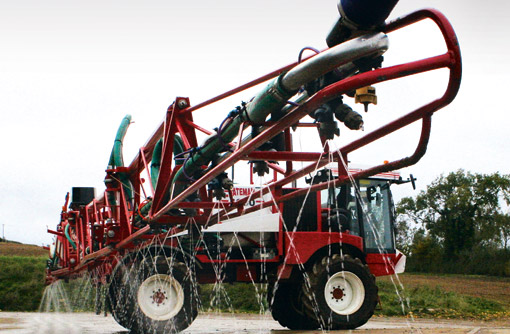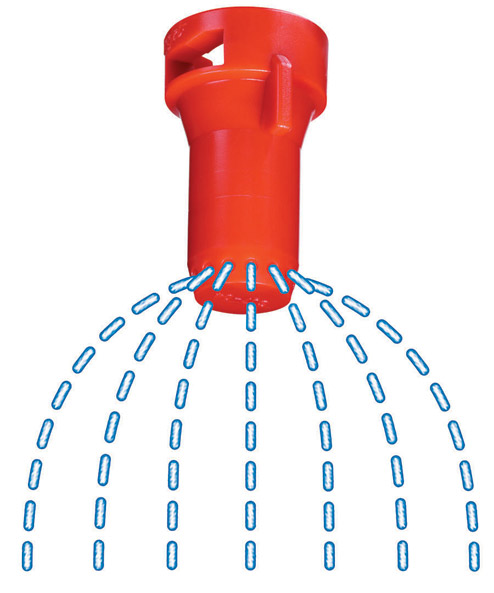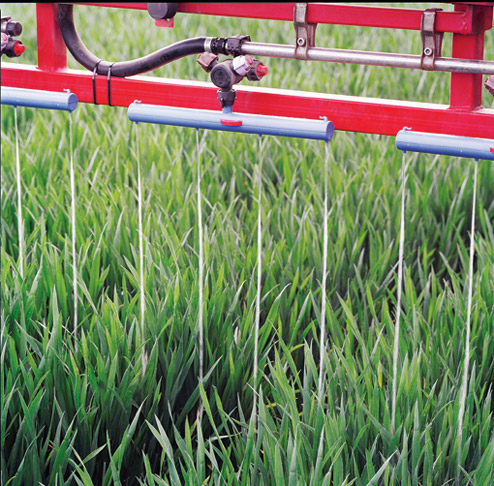Liquid fertiliser offers more application days

What is the quickest and most effective way to apply nitrogen to a big area of arable crops?
The answer from Guiting Manor Farms manager Nick Bumford is an emphatic “liquid”. It may not offer the same opportunities for buying cheaper materials, but from an application control point of view, liquid fertiliser has a lot going for it, he points out.
Being able to keep applying nitrogen in liquid form, when poor weather has solid spreaders confined to the farm shed, is a particularly welcome aspect of this approach for sprayer operator Wayne Rose. He is responsible for completing an annual workload of around 6,500ha of spraying and 3,720ha of liquid fertiliser application – all of it, ideally, at optimum timings.
“As long as you can travel and there isn’t a howling gale blowing, you can get liquid fertiliser on to crops; we can even work in light drizzle,” he points out. “That wouldn’t be the case with solid fertiliser being thrown to the sort of width we’ve got with the sprayer, so liquid opens up more days to get the job done.”
The applicator in question is a 4,000-litre Bateman RB35 self-propelled with a single-spray line boom extended to 32m for the 2013 crop year to match the farm’s new 8m drill.
A satellite positioning system and spray controller used for auto steering also provide variable rate application, which is exploited by using as many as eight different rates determined by crop canopy assessment.
It helps that the purpose-designed liquid fertiliser nozzles used provide a stable output pattern across a range of flow rates and operating pressures.
“I can work at 1- to 4-bar pressure giving plus or minus 15% variation from the main application rate without any issues,” notes Mr Rose.
Three different sizes of Pentair’s Hypro ESI nozzle are used for N applications through the season, starting with an 03 blue giving 89 litres/ha at 14kph and 2.5 bar for a dosing of 30kg N on oilseed rape seed-beds. The 08 white nozzle delivers 300 litres/ha for dressings of 20% N, 80% sulphur to oilseed rape or 100kg N to seed grass on a neighbouring racehorse enterprise.
“I’ve used dribble bars and different nozzles before, but changing to this fertiliser nozzle has made life easier,” says Mr Rose. “Dribble bars work well but they’re easily knocked out of shape so you have to spend time lining them up.
“And like the umbrella-pattern nozzle I used previously, they’re too big to use on a multi-jet if you want to select a spraying tip,” he points out. “Taking them all off on a 32m boom isn’t a lot of fun; whereas the ESI nozzles are so compact, I can just give the multi-jet bodies a twist to switch to a different size or nozzle type.”
The distinctive raised outlets of the ESI nozzle and the low pressure chamber behind them produce six identical streams of liquid to help minimise retention on the leaf and the risk of scorch.
“There’s no fiddly changing of calibration discs when you have to go to a different rate,” Mr Rose emphasises. “I usually run with two ESI nozzles and one spray tip on the triple-jet bodies during the fertiliser season and just walk along the boom switching nozzles as necessary.”
The farm’s location in the rolling hills of the Cotswolds, rising to 274m, can limit available working days.
“It takes longer to pump fertiliser into the tank than to dump it out of a big bag into a spreader,” Mr Rose acknowledges. “But that’s not crucial when the liquid technique allows us to put on fertiliser whenever we can travel; it gives us a much better chance of applying fertiliser when crops need it rather than when conditions allow.”
Accuracy is the other important factor: “The fertiliser goes on evenly across the full working width and we’re not short-changing headland areas by trying to keep the fertiliser out of hedgerows as with a spinner,” says Mr Rose.
“With 10-section automatic width control and the precise streams flowing from the nozzles in a compact pattern, I know exactly where I’m putting the fertiliser,” he adds. “It gives you confidence that you’re doing the best possible job.”
Liquid fertiliser stream bars
Albuz
Fertiliser nozzles with ceramic orifice – EXA three-stream (1- 3.5 bar in eight sizes) and ESI six-stream (1-4 bar in seven sizes from 015-06) for 50cm boom height.
ASJ Spray-Jet (ARAG)
PSP Pentastream nozzles produce five streams of liquid at 1-5 bar pressure; available in six sizes from 015-06.
Berthoud
Nozal Trifilet triple-stream fertiliser nozzle in eight sizes from 015-08 operating between 1.75 bar and 5 bar at 70-90cm boom height. R5X five-stream nozzle in seven sizes from 015-08 for 1.5-5 bar pressure and 35-100cm boom height.
Hardi
Quintastream nozzle producing five streams of liquid distributed at different angles and flows – highest flow from centre, lowest from outer overlapping streams. Nine sizes from 015-15 with 1.5-5 bar operating pressures.
Landquip
Agroco Umbrella in three sizes, each with three metering discs, for 80-1,500-litres/ha at 0.5m spacing. Horizontal outlets produce seven liquid streams of equal volume in an asymmetrical pattern.
Lechler
FD 130deg angled flat-spray nozzle in eight sizes from 03-20 operating at 1.5-4 bar pressure. Lecher FL with five horizontal outlets from stainless steel or plastic body calibrated using stainless steel dosing discs. Tube Drop assembly for placing FD or FL nozzles within crop at 0.5m spacing; Hose Drop T-bar assembly with dosing discs for surface liquid placement at 0.25m spacing.
Pentair
Hypro-EU ESI with outlets producing six slightly angled liquid streams; available in 10 sizes for application volumes from 20-1,400 litres/ha at 1-4 bar operating pressure.
TeeJet

StreamJet SJ-3 tip to fit Quick TeeJet cap produces three streams of equal velocity and volume from one vertical, two angled outlets; 10 sizes from 015-20. StreamJet SJ-7 tip (pictured) with seven horizontal outlets for overlapping application pattern; nine sizes from 015-15.
Liquid fertiliser dribble bars
Bateman Engineering

Accu-Rate four-outlet 0.5m dribble bar plus three-outlet body with flexible remote orifice for boom hinge areas, and so forth. Individual port feed and key-adjusted flow-rate setting mechanism with four positions. Joining links available to prevent misalignment.
Billericay Farm Services
Dribble Bar 0.5m applicator with four outlets from open-cavity tubular body and rotary dial to select five flow restrictor settings. AutoStreamer bar with four individually supplied outlets across 0.5m fed via pressure-adjusted flow-rate control valve allowing in-cab application rate adjustment. Hook-end body for “rubber band” anti-twist links.
Chafer Machinery
Streambar MultiRate in 0.5m and 0.33m sizes with six-position slide rate setting mechanism. Four-outlet body with individual port feed; available with Chafer or EF3 bayonet nozzle body fittings.

